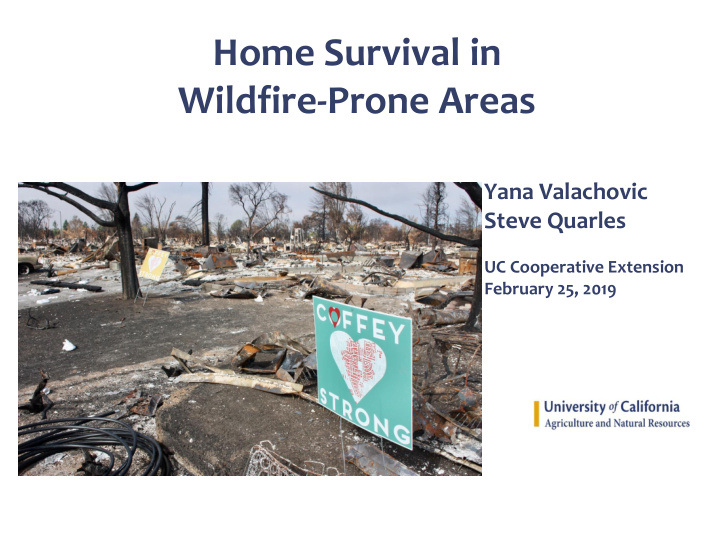



Home Survival in Landscaping and home design for wildfire defense Wildfire-Prone Areas Yana Valachovic Steve Quarles UC Cooperative Extension February 25, 2019
Take home points ➢ We don’t fight earthquakes, tornados, or hurricanes. We adapt and build smarter. ➢ The majority of homes are lost from embers ➢ New building codes are helping ➢ Need to incentivize upgrades to existing homes ➢ PRC 4290 defensible space ✓ Need a 5-foot noncombustible zone
How a house burns from wildfire? Ember / Firebrand Flame Contact Radiant Heat Tennessee Division of Forestry
Embers We Know That … Wind-blown embers are responsible for the majority of building ignitions USDA FS, R5-TP-015 Angora Fire – South Lake Tahoe
Structure Survival Priorities for Wildland Fire : Exposure from embers that may ① Roof / Edge have been blown a mile or more. ② Vents Embers can also ignite near-home vegetation and debris. ③ Vegetation/Defensible Space ④ Windows Ember, radiant, and/or flame impingement ⑤ Decks exposures from near- ⑥ Siding home vegetation, other structures, and wildfire
Points of Entry Rain gutter to roof edge Fence to house Roof to wall Photo: Tom Welch Insurance Institute for Business and Home Safety Ember entry via gable end vent Ember entry via under-eave vents
PRC 4291 Defensible Space Two zones: 0’ - 30’ - Defensible Space Zone 30’ - 100’ - Reduced Fuel Zone Defensible Space Reduced Fuel Zone . 30 ft. to 100 ft. 30 ft. Reduced Fuel Zone : Defensible Space Zone
Ember damage in Paradise 2018 Photos: Y. Valachovic Outside Cushion
Carr Fire 2018: broken windows from burned shrubs near the house Photo Y. Valachovic
Work from the house out Defensible space includes: Zone 1: 0- 5 feet “non - combustible zone” Zone 2: 5- 30 feet “lean and green zone” Zone 3: 30-100 feet or to the property line “reduced fuel zone”
What does a Paradise Camp Fire survivor look like? Photos: Y. Valachoic
For more information visit: • http://disastersafety.org/wpcontent/uploads/2017/03/WF_California_IBHS.pdf • https://disastersafety.org/ibhs/ibhs-nfpa-wildfire-research-fact-sheets/
Recommend
More recommend